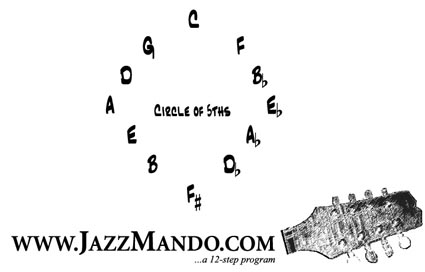« 3-note Chord Dominants; Part 1 (Inversions) |
Main
| 3-note Chord Dominants; Part 3 (Passing chords) »
 February 24, 2011 | 3-note Chord Dominants; Part 2 (Circle of Fifths) February 24, 2011 | 3-note Chord Dominants; Part 2 (Circle of Fifths)
Last week we introduced you to the concept of 3-note V7 chords and the subsequent inversions. If you haven't had the chance already to internalize these, we'd suggest going back for an intense review. The context was being able to move up the same chord, A7 for example, and voice it in it's three different incarnations up and down the fretboard. You would do well to practice shifting around these, if nothing else to get them to feel comfortable. Keep in mind EVERY 3-note V7 chord will be one of these four blocks, no matter what key you're in. It's simply a matter of moving up frets or over a string, and you have all 12 keys literally at your fingertips.

What we want to do now is go back to the way a V7 chord moves into another V7, otherwise known as the Circle of Fifths. We've mentioned this here before, and you may have heard the term bantered about in a jam session. The most familiar is any tune that uses "I Got Rhythm" as the basic chord layout, and in particular, the bridge of the song. It's very common, and you'll find a useful tool is being able to voice a progression of 5ths smoothly, such as they way we've blocked these in the diagrams below. Notice how even though the root of the chord is jumping an entire 5th (or 7 frets) A7, D7, G7, C7, you aren't moving more than two frets with these inversions. It's VERY fluid!
   
All we've done is utilize the inversion of the next chord that is closest. Don't worry about it as being 1st inversion, 2nd, etc. just know that it's the one that uses the least amount of jumping. You could even continue on through the Circle (F7, Bb7, Eb7, Ab7, etc) except you've run out of fretboard, and would have to continue an octave up.
Take a look at starting with the A7 in another inversion. Here's a way to voice it:
   
Again, very fluid, only a couple frets at the most. For you theory geeks, the 3rd and 7th "Tritone" is the center of it all, and each root movement up a Fifth slides the Tritone down one fret. Pretty cool pattern, eh?
Continuing on:
   
When we run our fourth and final variation, we run out of fingerboard on the G7 (at least if we want a closed position chord), so we have to move everything up an octave. Again, if you wanted to continue the succession of Fifths, F7, Bb7, Eb7, Ab7, Db7, etc. it's very obvious how this cycles on.
   
If you're playing "Sweet Georgia Brown" in the key of F major, you can use the 2nd, 3rd, and 4th of these blocks. Another is "Autumn Leaves." You'll be surprised at how many use a succession of three more V7 chords in this relationship, and with this under your belt, you're at the ready immediately!
Further:
3-note Chord Dominants; Part 1 (Inversions)
Fretboard Geometry
Circle of Fifths Examples
Secondary Dominants
What you can do with a V7 chord: Declaring Dominants
Posted by Ted at February 24, 2011 6:23 AM

Disclaimer: In the 'Information Age' of the 21st Century,
any fool with a computer, a modem, and an idea can
become a self-professed 'expert." This site does not
come equipped with 'discernment.'
|



